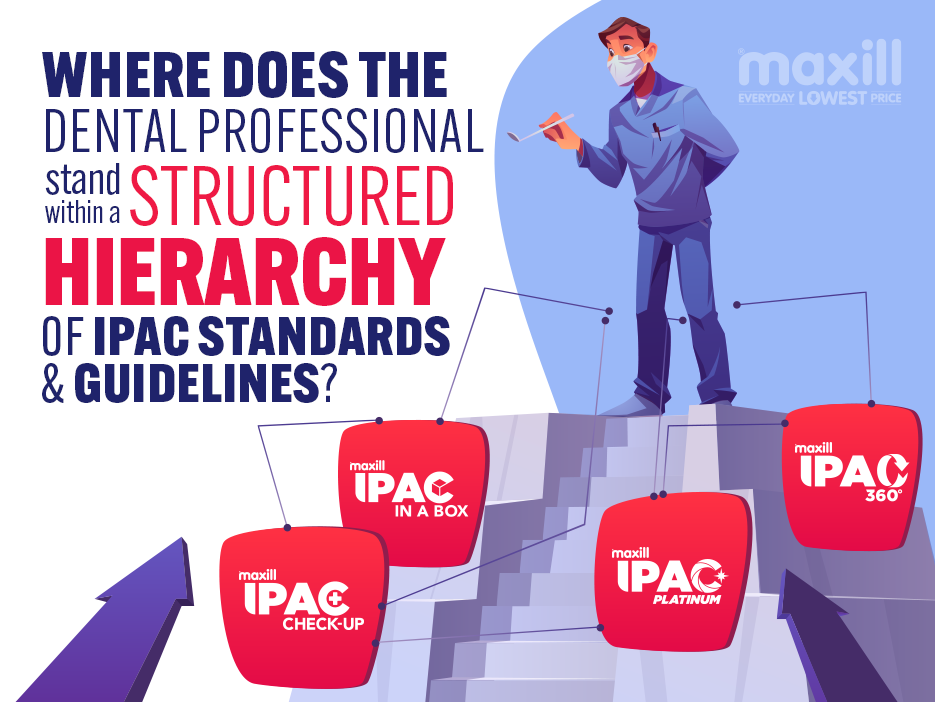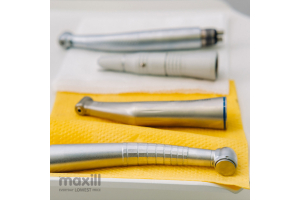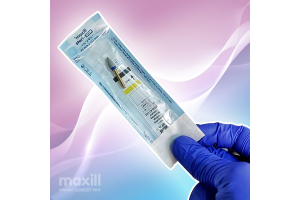Where Does the Dental Professional Stand Within a Structured Hierarchy of IPAC Standards and Guidelines?

Where do the IPAC Standards in Canada originate? To simplify, the hierarchy revolves around the Canadian Standards Association Group (CSA). CSA is organized with technical committees under the jurisdiction of the Strategic Steering Committee on Health and Well-Being. Standards are developed and in compliance with the Standards Council of Canada requirements for National Standards of Canada, then published as a National Standard of Canada by CSA Group (CSA, 2023).
Where does Public Health Agency of Canada (PHAC) fit in? Since its establishment in 2004, PHAC is a federal department that operates separately from Health Canada reporting directly to the Canadian Minister of Health (Marchildon,2008). PHAC works with Chief Public Health Officers in the municipal and provincial sectors. At the municipal level are the local Public Health Units (PHU).
Where do you and I fit in as dental professionals in this line up? Dental regulatory colleges obtain their IPAC information from provincial Public Heath Agencies. The dental regulatory standards and guidelines reference their evidence based ‘decisions’, often quoting the CSA and provincial Public Health Agency.
An example of a public health agency’s, mandate, is the following from Ontario:
“PHO keeps Ontarians safe and healthy. With our partners in government, public health and health care, we prevent illness and improve health. We provide the scientific evidence and expert guidance that shapes policies and practices for a healthier Ontario (PHO, 2024).”
What it the mandate of the municipal local public health units?
“Public health units (PHU) offer healthy living and disease prevention information and programs to their communities. At the local level, they lead programs focused on the prevention and control of communicable diseases, including monitoring local data to tailor their programs to what is happening in their community (PHO, 2020).”
Back to you and I in our dental offices, who audits a dental practice? Public Health provincial or municipal? Municipal public health units as they are responsible at the local level to lead programs focused on the prevention of transmissible diseases (PHO, 2020). If the local PHU receives a complaint from the public of a hazard in the community about a dental office that is being questioned for public safety, it is their duty to investigate and HELP the dental office mitigate the hazards. Correct, the word ‘HELP’. PHU’s are not policing dental practices, they are auditing to assist the dental office towards corrective action. During an IPAC audit the hazard is evaluated as a high, moderate or low risk. The corrective measures and the time to complete these actions, are dependent on the level of risk. Obviously placing high risk goals at the top of the list.
Who is the PHU auditor? A trained healthcare professional that holds certification in Medical Reprocessing. What standards do the PHU auditors reference? Right back to the beginning of this article, the CSA Group. For example, in Ontario the PHO dental setting reprocessing IPAC checklists, specifically reference CSA – Z314-18 medical reprocessing standard, updated in 2023 to CSA – Z314-23 and now titled Canadian Medical Device Reprocessing in All Healthcare Settings.
Who developed the dental setting IPAC checklist the PHU auditor uses? Specific to Ontario, Public Health Ontario developed the checklist in collaboration with dental regulatory bodies and the Ministry of Health and Long-Term Care (MOHLTC) as well as referencing resources from Provincial Infectious Disease Advisory Committee’s (PIDAC).
What does PIDAC do?
“PIDAC-IPC is a multidisciplinary committee of health care professionals with expertise and experience in Infection Prevention and Control. The committee advises PHO on the prevention and control of health care-associated infections, considering the entire health care system, with a focus on clients, patients and residents, as well as health care providers. PIDAC-IPC produces best practice documents that are evidence-based, to the largest extent possible, to assist health care organizations in improving quality of care, as well as client, patient and resident safety (PHO, 2024).
Go back to the PHO dental setting reprocessing IPAC checklists to note the use of evidenced based PIDAC resources.
In conclusion, where does the Dental Professional stand within a Structured Hierarchy of IPAC Standards and Guidelines? The dental professional stands at a vantage point of having access to quality information to ensure the delivery of safe care. There is certainly no lack of information to make best practice decisions. When the dental professionals read the dental regulatory standards and guidelines and are unsure of their application to their practice setting, or can’t decipher which approach for interpretation, take advantage of the hierarchy. Reach out to the local PHU’s, ask questions, ask for resources, get informed. Reach out to the practice advisors from regulatory bodies. The worse thing to do is nothing when the hierarchy is organized to support our every IPAC move. An important discussion is also compliance in understanding the standards and guidelines and acting as per those standards and guidelines because of public safety as it’s the ‘ethical thing to do’. Turning a blind eye to IPAC standards or striving for the catch phrase “I will do it only once I am told to and when I am audited” is not in the professional’s best interest (nor the public). Positioning the direction of the words shall, must, should and may to aim for the least possible action is also an issue. Read the next maxill blog article all about the ‘Hawthorne Effect’! Compliance should not be executed because we may have an IPAC audit, but rather because we believe in the culture of IPAC stewardship and our responsibility to the public, safeguarding our practice and upholding the integrity of the dental profession.
Resources
- Canadian Standards Association (CSA). (2023). CAN/CSA-Z314:23, Canadian Medical Device Reprocessing in All Healthcare Settings. National Standard of Canada by CSA Group. Access via purchase: https://www.csagroup.org/store/product/CSA%20Z314%3A23/?gad_source=1&gclid=CjwKCAiAqY6tBhAtEiwAHeRopTg3YwxdAo0LCsCKf-3iMwQMppeCJlGeaM0y-bNZ3tsJlx92_yLU8BoCGsEQAvD_BwE
- Marchildon G. P. (2008). Canada, Health System of. International Encyclopedia of Public Health, 381–391. https://doi.org/10.1016/B978-012373960-5.00302-6
- Public Health Ontario. (2020). Ontario Public Health System. Public Health History. https://www.publichealthontario.ca/en/About/News/2020/Ontario-Public-Health-System#:~:text=Public%20health%20units%20(PHU)%20offer,is%20happening%20in%20their%20community.
- Public Health Ontario. (2024). Provincial Infectious Diseases Advisory Committee on Infection Prevention and Control (PIDAC-IPC). https://www.publichealthontario.ca/en/About/External-Advisory-Committees/PIDAC-IPC#:~:text=PIDAC%2DIPC%20produces%20best%20practice,client%2C%20patient%20and%20resident%20safety.







